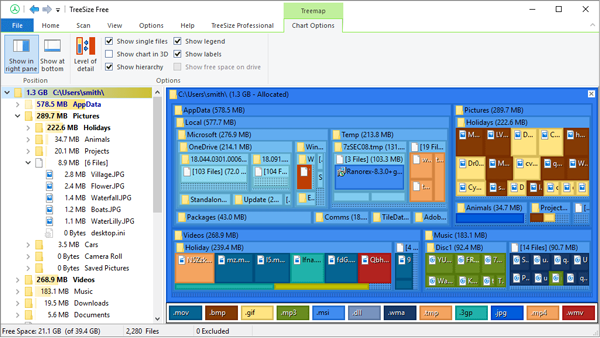
- #Treesize free how to use install
- #Treesize free how to use update
- #Treesize free how to use full
- #Treesize free how to use windows 8
If you wish, you will be able to set your schedule for which the program will run, it will run itself, do everything necessary, save the report and then you can view it. If you want, you can work through the command line, the developers write that it is very convenient for night runs, not very clear what we’re talking about, but if convenient, let it be so.

TreeSize can find all kinds of old files, you can make the search only among large files, you can find empty folders, temporary files. The chart looks very convenient, all received data will be displayed in such a graphical form, you will also get a good search system and the ability to import and export the results in XML files. Now by clicking on any folder you will be able to immediately view the number of files inside it, find out the date of last access to the folder and files, you can see who owns the files and more, I suggest you to get acquainted with more details yourself.
#Treesize free how to use full
If you have quite a few Windows 2008 R2 servers, you can automate this process by using this PowerShell script.There is a new version of a good program that displays the directory tree on your hard drive, and you can immediately see the size of all the folders, and if you have a great desire to print the data you receive, you can do it without any problems, just select the print mode and this manipulation can be finished, you can download TreeSize to the full news.Īfter installation the program will be integrated into Windows Explorer, which means you will get a new column for working with your directories. Note that you may need to restart the server to see the difference. Now let’s run TreeSize free tool again and see how much space I gained from this process. In my case, that’s going to free up almost 6GB of space from my system drive.
#Treesize free how to use update
Go to Start → All Programs → Accessories → System Tools, and launch Disk Cleanup.Ĭheck both Service Pack and Windows Update Cleanup, as well as any other related to the upgrade.

Now let’s get to the real cleaning process. It doesn’t require a reboot once it’s installed. Go to this download page and download the update specifically for Windows Server 2008 R2.
#Treesize free how to use install
Next step, you will need to install a separate Windows Update that adds an additional option to delete outdated Windows updates. Once it’s done, restart your server to finish the installation process. A wizard pops up.Ĭheck Desktop Experience from the list, click Add Required Features if another window pops up, go to Next, and Install. Go to Control Panel → Turn Windows features on or off, and click Add Features in Feature Summary section. Unfortunately, it’s not installed by default when you first installed Windows Server 2008 R2. So, the first step we need to do is to install Disk Cleanup utility which is part of a system feature called Desktop Experience. The proper way of doing things like this is to use a built-in tool called Disk Cleanup. If you have a 2008 R2 server that runs short on the system drive, this post will definitely help you.īefore I took the same steps on one of my servers, I used a free folder analysis tool called TreeSize Free to check my system drive to see how many spaces are occupied by this WinSxS folder, a total of 14GB.


#Treesize free how to use windows 8
We have a post that describes how to clean up WinSxS folder on a Windows 8 computer but unfortunately, the same step doesn’t seem to be working on a Windows Server 2008 R2 system. But you can do so if you are running short on space by following the right direction. Microsoft recommends not touching this WinSxS folder for the purpose of gaining more disk space. It does grow over time as more updates, features, or roles are added to the installation. It’s located in c:\windows folder containing all the files required to finish these installations. WinSxS, a folder called the Windows Component Store that is used during Windows updates, Service Packs, and hotfix installations.


 0 kommentar(er)
0 kommentar(er)
